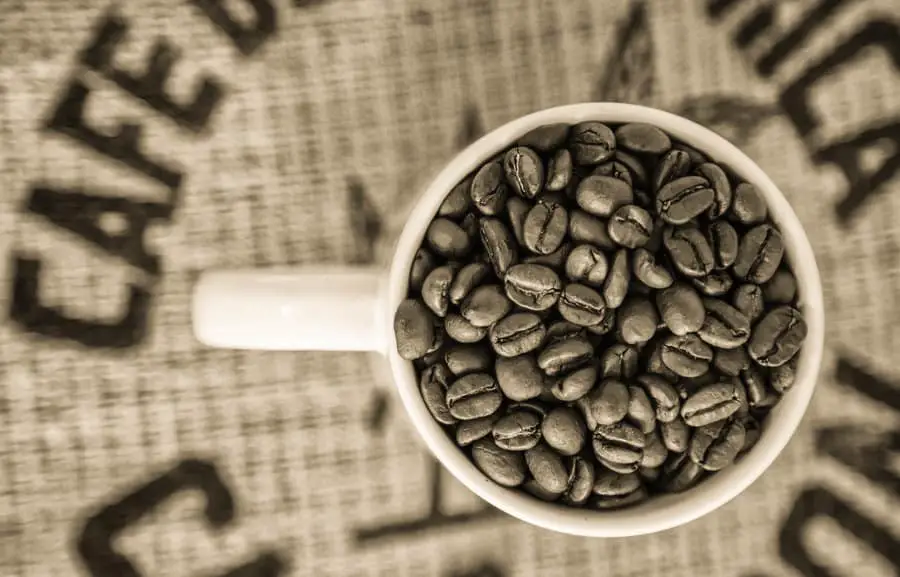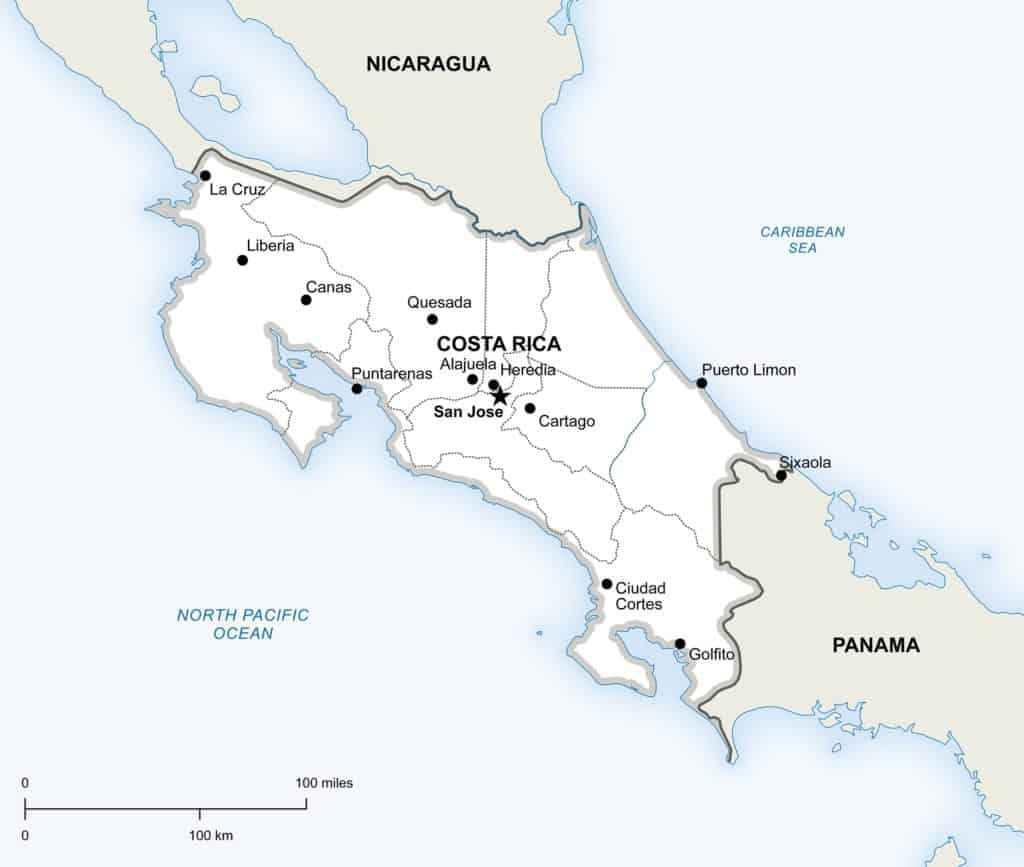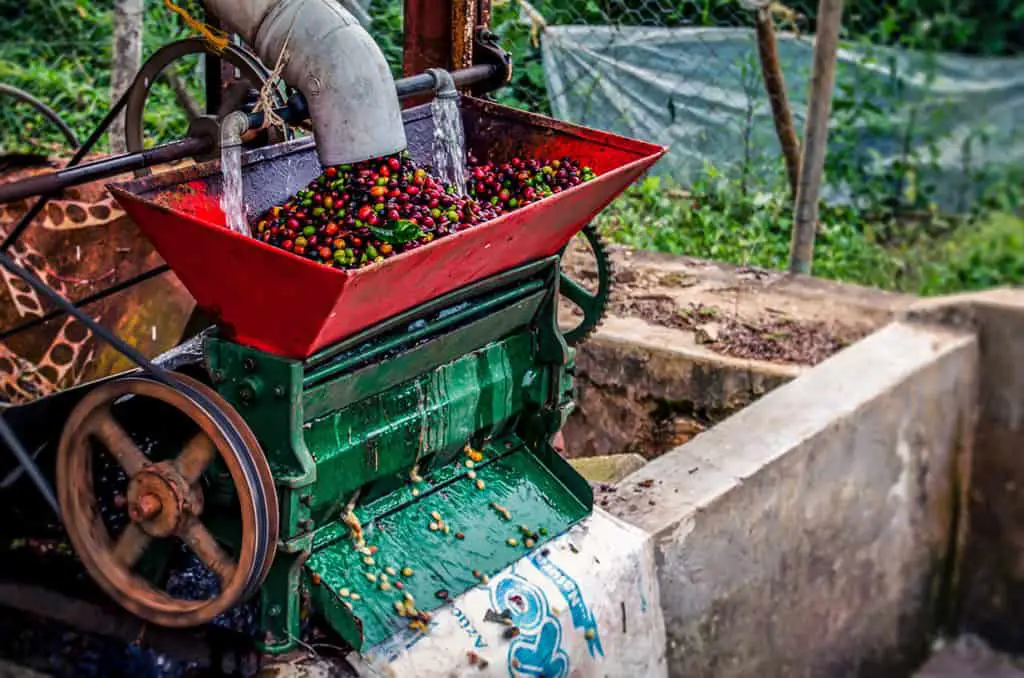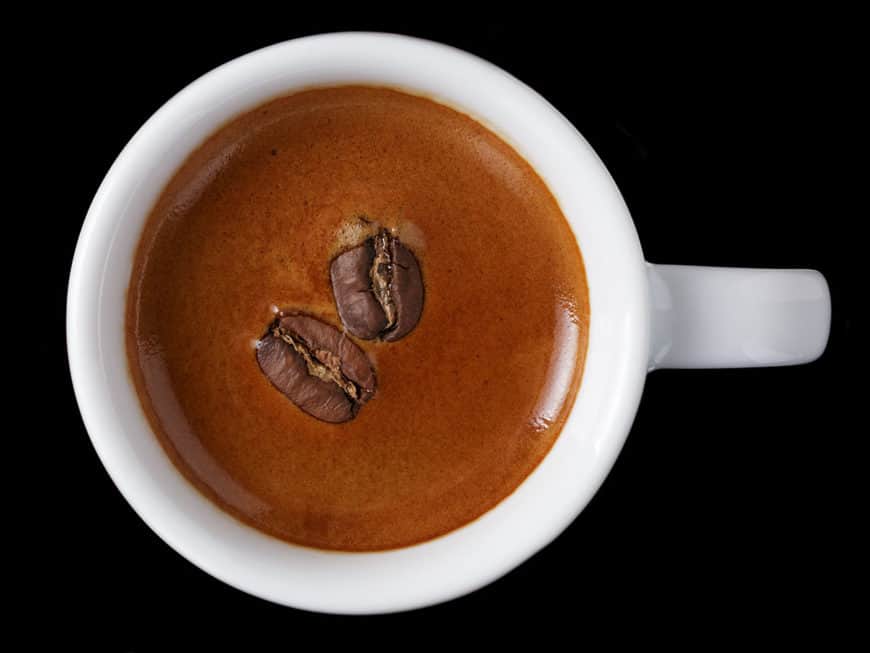
Why Costa Rican Coffee is the best is due to the plant varieties used, the unique areas in which the coffee is grown and the way the coffee is processed and harvested.
If you have ever been to Costa Rica one of the most memorable experiences, you will come back with is the taste of the coffee. On the other hand, if you have never been to Costa Rica or have never tried a cup of coffee from Costa Rica you are in for a real treat. This small but amazing country produces some of best and highest quality arabica coffee in the world.
Read on to learn a little more about this country and whether the coffee that it produces is something you should try the next time you need to get a bag of coffee.
The Beginning of Coffee in Costa Rica
Costa Rica is pretty well known for a few things; mountain ranges, perfectly conical volcanos, pristine beaches, an equatorial climate, dense jungle and, most importantly (to the coffee world at least), sweet coffee with crisp and vibrant acidity. When one digs into a new bag of Costa Rica, you can be pretty sure the coffee will be sweet and will have the vibrancy of a fresh green apple.
Other than being known as an origin with outstanding coffee, Costa Rica has a couple of other feathers in its hat when it comes to coffee. The first; Costa Rica back in the 1820s, was the first Central American country to have a fully-fledged coffee industry.
The Costa Rica coffee industry flourished and grew quickly, making coffee one of the countries’ major agricultural exports, along with cocoa, sugar, and tobacco (which coffee quickly surpassed).
This all happened in a relatively short period of time, considering the crop was only first brought to the West Valley region of the country in 1779, with its first commercial production in 1808 followed by its first exports in 1820.
The rapid growth of the countries coffee industry has been linked, in large part, to backing and incentives put in place by the government of Costa Rica, who clearly saw a way to boost the county’s newly independent economy with this beautiful and lucrative crop.
The second, and by far the more delicious feather in it’s Panama– it’s gift to the world; the honey processing method. We’ll get further into this shortly, but the honey processing method, a hybrid technique between washed and natural processing methods, originated in Costa Rica, with different variations found from producer to producer.
What are Coffee Growing Regions of Costa Rica?

If you were to look at a map of Costa Rica, and you pinned out all of the coffee farms and growing regions with little red needles, what you would end up with is a reasonably neat cluster of pins toward the center of the country– both latitude and longitude wise.
While there are around eight coffee growing regions in Costa Rica, the major points of focus, and the main areas from where most of the quality specialty grade coffee comes in Costa Rica, is the Tarrazu and the West Valley regions.
These areas are both high altitude; in the case of Tarrazu– up to 2000 meters above sea level, and the West Valley, slightly lower at around 1200-1900 masl, with both areas crops growing in nutrient-rich, volcanic soil.
The other six growing regions are the Central Valley, Brunca, Guanacaste, Tres Ríos, Turrialba, and Orosi.
Tarrazú
The Tarrazu region is almost as well known for its stunning views of flowering coffee plants through lush forest in the growing season, as it is for stunning coffee it produces after the harvest.
Coffees coming out of the Tarrazu region of Costa Rica, often exhibit some pretty fantastic flavor profiles, somewhere in the neighborhood of floral, vanilla, cocoa, orange, nougat, and caramel notes in the cup.
The coffee produced here is considered to be the best in the country, and to some, the best coffee in the world.
During the growing season, which is also the wet season in Terrazu, the region is home to around 10,000 people. During the harvesting season, which lines up with the dry season, the number of inhabitants roughly triples.
Partly due to the climate being cool and humid most of the year which makes for less than ideal conditions for drying coffee, many of the mills in the region are producing washed process coffees and using mechanical dryers, rather than using natural or honey processing methods.
West Central Valley
The West Central Valley, Costa Rica’s west-most coffee-growing region, produces around twenty-five percent of the country’s total coffee. The coffee crops grown here are generally done so at an altitude lower than that of Tarrazu— between 1200 and 1700 masl.
This is where many of the country’s natural and honey processed coffees come from, though many producers here also process washed coffee, too. It might be tempting to assume that because the altitude of the coffee grown in the West Valley is lower than Tarrazu, the coffee cherries are of lower quality.
And while this may be true in some cases, it is certainly not a safe blanket statement– the region is home to a very high percentage of Costa Rica’s cup of excellence winners in recent years.
In the cup, one can usually expect anything from chocolate and honey, all the way down to stone fruits like peach and apricot and in the case of naturally processed coffee, even tropical fruits like jackfruit and pineapple.
Central Valley
Lying just east of the west valley growing region, not surprisingly in the central highlands, we have the Central Valley. Coffee grown in the Central Valley makes up for around 15% of the entire country’s coffee production.
Growing altitudes here are between 1000 and 1200 meters above sea level, with coffee growing in tropical volcanic soil which provides high levels of nutrients to the plants.
Brunca
Brunca is the south-most coffee producing region in Costa Rica. It is the third largest producer of coffee in the country, trailing just behind the West Valley and making up 20% of national coffee production.
Most coffees grown in Brunca are generally done so at altitudes of 800-1200masl, quite a bit lower than in Terrazu and the West Valley. While lower growing altitudes are common here, there are farms in the area growing coffee much higher, closer to 1700masl.
Coffee coming from the lower and midland areas of Brunca often have a very soft flavour profile, while coffee in the higher lying areas, such as Pérez Zeledón at 1700m, have more complex orange and jasmine notes in the cup.
Guanacaste
The Guanacaste growing region is primarily made up of many small producers, scattered over quite a large area. Due to high temperatures, coffee plants in the Guanacaste region are grown in the shade of various forest trees.
Coffee is grown here at an altitude ranging from 600-1300 masl. Partly because of the area’s warm climate, the coffee beans produced here are quite soft when roasting, making them less desirable.
Coffees from the Guanacaste region are characterized by obvious bitter and salty notes.
Tres Ríos
Just a few kilometers from the country’s capital, San Jose, sat on the slopes of Irazú Volcano, lies the wonderful growing region of Tres Ríos. Tres Ríos is geographically one of the smallest growing regions in the county. Thanks to its small size, the climate and soil in the region is much the same from farm to farm.
Coffees grown here are done so at high altitudes of up to 1650 masl. The region is well known for producing spectacular coffees, as good as anything coming from Terrazu, with notes such as orange zest, stone fruits and honey.
Turrialba
Named after the volcano that towers to its south-west, the growing region of Turrialba is one of the wettest in the country. Wettest, meaning, it gets high amounts of rainfall, reasonably constantly throughout the year. Because of this, the area has multiple harvests each year.
The coffee cherries here grow at up to 1400 masl, and are characterised by their large size.
In the cup, coffees from Turrialba have a delicate aroma, light body and mild acidity.
Orosi
Located 40 kilometers from the capital, San Jose, the Orosi region is one of the oldest coffee growing regions in the country. The region’s coffee production dates back to over 100 years.
These coffees often exhibit strong notes of cocoa with vibrant acidity and sweetness.The area has, on average, 210 rainy days per year, and high humidity, meaning it is considered one of the wetter regions of Costa Rica.
Coffees grown in the Orosi region are done so in nutrient rich volcanic soil, at an altitude of between 1000 and 1400 meters above sea level.
What are the Coffee Varieties in Costa Rica?
The only species of coffee growing in Costa Rica– that is to say, the only species that is allowed to be grown in the country, is Coffea Arabica. The growth of the robusta species is outlawed in order to keep the quality standards of the country high.
Off of this main species, arabica, we have multiple different cultivars– coffee plants that have been cultivated or mutated into new varieties.
Some of the most common coffee varieties in Costa Rica are Caturra, Bourbon, and Catuai. While these may be the most common, there are a number of farmers growing more experimental varieties such as SL-28, which is a plant typically seen in Kenya, and Geisha— a crop that is notoriously hard to grow and demanding to harvest, originally from Ethiopia’s Gori Geisha forest. Having said that, Costa Rica is also home to its own native coffee varietals.
Villa Sarchi, which is a natural mutation of the Bourbon variety, is one such Costa Rica specific variety. Its mutation is a single-gene mutation that causes the plant to grow smaller (dwarfism). It is well-adapted to high altitudes, is tolerant of strong winds, and requires nutrient-rich soil– perfect for the volcanic hills of Costa Rica.

Harvesting Coffee in Costa Rica
Coffee harvesting in Costa Rica is done by hand, which is why, as I mentioned earlier, the population in certain areas roughly triples. Most of Costa Rica has two distinct seasons; the wet and the dry season.
The dry season is the time for harvesting, and it runs from December up until April.The ripe coffee cherries are picked by hand, before being transported to the processing facility for sorting, processing, drying, and packing.
Costa Rica has made itself stand out in the coffee world in many ways. From planting experimental, hard to grow crops, to educated farmers with innovative farming techniques. But probably the biggest impact, and what Costa Rica may be most famous for, is a unique, hybrid processing method. We’re talking about the honey processing method. \
Washed Coffee
A washed coffee, in general, will have a very clean flavor profile. When tasting a washed coffee, it is essentially the coffee seed, and the flavors of the roast, that you are tasting. There is no outside influence from the fruit from where it came, and ideally, the process it underwent.
Once the ripe coffee cherries have been picked from the trees during the harvest season, they are then sorted, as to leave only similar color, weight and size cherries left together.
The coffee is then transferred to a de-pulping machine, where the fruit is cut and separated from the seeds within. After this stage, the coffee will be covered in a sticky, thick, ‘honey’ like substance called mucilage. To continue as a washed coffee, the mucilage needs to be removed.
The coffee seeds are transferred to a tank of water, where they will ferment for between 12 and 72 hours, depending on climate, altitude and the coffee itself. During these hours of fermentation, bacteria will build up, and naturally occurring enzymes will cause the mucilage to dissolve.
After fermentation, the seeds are rinsed, dried, and finally, the parchment (a thin layer of skin) is mechanically removed from the bean. The beans need to be dried down to a moisture content of around 11%, before being packed and prepared for export.
Most of the coffees we see coming out of the Tarrazu region are washed coffees.
Natural Processed Coffee
The natural processing method, or the ‘dry’ process, is the original way of processing coffee. It is used in many countries around the world today for both for its flavor profile, and its non-reliance on water availability.
In countries like Ethiopia and Brazil, where water can often be not so readily available, the natural process is common.
Natural coffees, to speak generally, have tropical fruit– mainly pineapple and jackfruit flavors in the cup. This powerful fruity flavor is thanks to the cherry that the seed is dried in, imparting its flavors on the seed.
To be done well, a naturally processed coffee needs to be subject to conditions that are just right. It needs enough sunlight, heat, and humidity. It also heavily relies on a watchful eye of the producer to ensure correct and uniform drying.
When everything goes as planned, a naturally processed coffee can be an absolute treat– fruity, delicate, clean, balanced, and most of all, sweet. Incredibly sweet.
Having said that, the natural processing method, otherwise known as the ‘dry’ processing method, isn’t well known among coffee geeks for producing clean, transparent tasting coffee.
On the contrary, the natural processing method has garnered a reputation for producing coffee with somewhat undesirable flavor characteristics— coffees with an unpleasant, ‘natural’, fermented taste to them. Think; red wine. A boozy kind of flavor. This is thanks to over fermentation which can occur while drying.
First, the coffee cherries are picked and sorted. Then, they are transferred to the drying area where they will dry and shrivel up like a raisin, before being hulled by a machine which separates the dried fruit (this fruit we call cascara) and the parchment from the dried bean. Drying can also be done using a machine, similar to a big clothes dryer.
The natural process is used throughout all growing regions of Costa Rica but is more common in the lower altitude areas.
Honey Processed Coffee
The coffee producers in Costa Rica are innovative– constantly trying to find ways of improving the quality of their coffee in the cup. The more desirable the flavor profile of a coffee is, the higher the price it will fetch for the producer.
Faced with tight water restrictions, and the not ideal profiles of naturally processed coffees, the honey process was developed. This process, and the degrees of honey-ness, varies quite a lot from producer to producer.
First, the coffee cherries are picked and sorted. As with washed coffees, the cherries for the honey process are then transferred to a machine for de-pulping, only this time, the producer can adjust the machine, telling it how much of the sticky, sweet, mucilage– how much of the ‘honey’, to remove.
Generally, the more mucilage left on the seed intact, the more intense fruit and sweetness in the cup. However, the more mucilage left on the seed, the more at risk of molding and over-fermentation the coffee is.
What are the Four Types of Honey Processed Coffee
The honey processing method is a sort of hybrid between the washed and natural processing methods. The ideal goal with a honey processed coffee is to achieve the sweet and fruity character of a natural coffee, with the clean, transparent profile of a washed coffee.
1. White honey
White honey is the closest on the scale to a washed coffee. With this process, 80-100% of mucilage removed from the seed.
2. Yellow honey
For the yellow honey process, 50-75% of mucilage is removed.
3. Red honey
Red honey is getting close to a natural coffee, and when dried, is quite dark in color, similar to caramel. The red honey processing method removes 0-50% of the mucilage.
4. Black honey
With the black honey process, essentially only the skin and the thin layer of fruit are removed from the seed. Most of the mucilage is kept intact, with either none or very little of it removed.
Coffee Drying in Costa Rica
Before coffee is shipped to its destination, before it can be roasted and turned into the delicious beverage we know and love, the coffee needs to be dried.
Drying happens after it has been processed, and can be done in a variety of ways.
The coffee seeds are often placed on concrete or brick patios, in the sun, and left under careful supervision and several times a day turning and raking, to dry. Where a large patio is not available, raised drying beds are utilized.
These beds, also known as African drying beds, are often used in conjunction with shade netting in order to achieve the correct amount, and speed, of drying.
In other cases, a technique of piling the coffee into small mounds during drying is used in order to slow the speed at which the coffee dries on the patios. This allows certain elements of the seed to be drawn out and pronounced.
Some producers also implement the use of a mechanical drier. They do this in times of non-ideal drying conditions, and/or to fine-tune the moisture content of the already sun-dried beans.
Terroir in Costa Rica
The area of land a coffee is grown in, the growing region, can have a huge effect on the flavor of the coffee that will end up in the cup. The term for this, the environmental factors at play outside of our human control, is known as the lovely French word; Terroir.
Terroir is a term that is used to describe the soil, the altitude and the climate of a growing region. These factors, whether growing grapes for wine or coffee to roast, can and do play a huge roll in how the same plant– the same variety, planted in two different places, could taste so dramatically different.
But what makes a region stand out high above the rest?
Soil
The soil of Costa Rica, being nutrient-rich volcanic soil, is ideal for growing. Not just growing coffee mind you, but growing anything. Many coffee varieties, especially some of the rarer and more prized ones, require high amounts of nutrients from the soil, in order to grow and subsequently, flower.
Climate
Coffee, especially Arabica coffee, relies heavily on the right climate in order for it to grow, and to flourish. For a coffee plant to do well in a certain area, it needs to check quite a few climate-related boxes.
First, we need a distinct wet and dry season. The wet season, with frequent rain, will allow the coffee plants to grow and mature. We need the dry season to allow proper harvesting and adequate drying.
The arabica species of the coffee plant, which is what is grown in Costa Rica, grows optimally in temperatures ranging from 18-21°C, though it can tolerate a mean annual temperature of up to 24°C. Temperatures higher than this accelerate the speed at which the fruit grows, not allowing complex sugars to develop in the seed, among a wealth of other problems the plant will face.
While the climate in Costa Rica, and in other places around the globe, has been ideal for some time, climate change is rapidly affecting the flowering cycles of the plants, and therefore when and how fast they produce fruit.
Altitude
It is pretty common knowledge that coffee grown at higher altitudes is better. There is less available oxygen at these higher altitudes, which means the coffee cherries, and the seeds contained within the fruits, grow more slowly.
They develop higher and more complex sugars and, in turn, a more complex flavor profile. These higher altitude seeds snatch a higher price because of their complexity.
The altitude at which most of Costa Rica’s coffee growing regions sit, is perfect for growing high-quality coffee.
Almost everything about Costa Rica makes it prime for producing exquisite coffees. From its government-run initiatives to its geography, its educated farmers with a vast knowledge of the crop and processing methods. Some of the coffee coming out of the area are truly outstanding.
The flavor complexity, sweetness, and standout acidity are a heavenly combination, and something almost impossible to find the same elsewhere.
How to Brew Coffee From Costa Rica
To brew the coffee that comes from Costa Rica, there are the usual ways such as using a French Press, Chemex or even an Aeropress. But if you really want to brew coffee like a Costa Rican then the best way to do this is by using what is a called a Chorreador or more commonly known as “the sock”.
Now this method is not the fanciest way to brew coffee but its certainly the most authentic way and is the traditional way that you will see coffee brewed if you go to a “ticos” home. If you have never brewed coffee this way, you should certainly try it! You may never go back to those “fancy” coffee makers ever again!
Buying Coffee From Costa Rica
The ideal way to buy coffee from Costa Rica is from your local roaster. This way you can make sure the coffee is fresh roasted and its always a good idea to support local. Make sure to that coffee you buy is just from Costa Rica and not a blend of Costa Rica and other coffee’s.
If you live in a area that does not have a local roaster or who doesn’t have coffee from Costa Rica, your next best option is to try to order it directly from a coffee producer in Costa Rica or from a site like Amazon or with Cafe Britt
By far the largest producer and most well known company is a company called Cafe Britt. If you have ever been to Costa Rica, you will know what I am talking about because they are everywhere from the airport to your hotel gift shop.
Although Cafe Britt is this large because they do a good job and have some excellent coffee, there are many others coffee companies to choose from and I listed the more local ones with well roasted coffee and that you can find on Amazon.
You can check them out directly but the shipping costs and the time it will take to get to you may make it less cost effective.
NOTE: When buying coffee try to buy coffee try to get whole bean and that has been roasted as close to your order date as possible.

